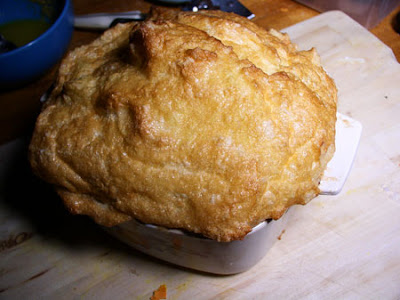“…A pie called macaroni, which appeared to be a rich crust filled with onions or shallots, which I took it to be, tasted very strong, and not very agreeable. Mr. Lewis told me there was none in it; it was an Italian dish, and what appeared like onions were made of flour and butter, with particularly strong liquor mixed in them.”
Category Archives: pasta
The Battle Creek Diet, Day 3



Well, it’s Wednesday, and Wednesday means Lost and Top Chef. So tonight turned into an impromptu debut dinner party with the arrival of my boyfriend and two friends. And it went well–very well.
 Glorious!
Glorious!
Temporal Fusion Cuisine: Fiamma’s Gnocchi
Chef Fabio Trabocchi prepared a gnocchi recipe, exceptional in it’s preparation of the potatoes, which are placed in a dutch oven with hay, and left to smoke and smolder on a stove top. The result is a potato that is infused with the smokey flavor of a dish cooked over an open fire. The recipe also calls for the addition of a pinch of nutmeg, a flavour very common to 19th century cooking.
When I took a bite of the tender potato dumplings, the combination of the nutmeg and the smokiness instantly transported me back to my time at a living history museum, and the hearth-cooked meals we would prepare. This is a dish I would dub “Temporal Fusion Cuisine,” a phrase I coined to describe food which relies heavily on flavors or techniques from culinary history, and combines it with contemporary culinary culture. Although Trabocchi did infuse the hearth-cooked flavor intentionally, I don’t think he intended the strong references to 19th century American cookery that this dish contains. Additionally, it was incredibly delicious, and I encourage the home chef to give this one a whirl.
You can get the full recipe here, and watch Trabocchi prepare the dish in the video below.
The Feedbag Makes Gnocchi with Fabio Trabocchi from The Feedbag on Vimeo.
Eating like a Tenement Family: Day 2
On the subject of broth, Juliet Corson has this to say:
“I wish to call your attention to the following important fact. The hardy and thrifty working classes of France, the country where the most rigid economy in regard to food is practiced, never use tea or coffee for breakfast, and seldom use milk. Their food and drink is BROTH.”
With this is mind, I pulled last night’s broth from the refrigerator, and poured it into a mug to be reheated in the microwave. It smelled like farts, and there was some sludgy stuff on the bottom I decided I couldn’t stomach, so I threw that out. I added a little water to thin the rest out.
I toasted a slice of bread as well, from a loaf of fresh-baked Italian bread that cost .99 cents. It works out to about .07 cents a slice.
All in all, the broth wasn’t bad. It tasted like a rich soup, which is not necessary what I want to eat first thing in the morning, but it made the hunger headache I’ve had since last night go away. I felt full, but not really satisfied. I give breakfast broth a B+, although I think it will grow on me.
Cost: .07 cents.
Lunch: Baked Beans
I decided it wasn’t cost effective to make baked beans from scratch, as it was very labor intensive and used many items that I don’t usually have in my pantry. So instead, I opened a can of Campbell’s Brown Sugar and Bacon Baked Beans, cost .59 cents. Done and done.
Cost: .59 cents
Supper: Macaroni with Cheese
“Boil half a pound of macaroni…put it into a pudding dish in layers with quarter of a pound of cheese, (cost four cents,) grated and mixed between the layers; season it with pepper and salt to taste; put a very little butter and some bread crumbs over it, and brown it in the oven. It will make just as hearty and strengthening a meal as meat, and will cost about twelve cents.”
Ms. Corson suggests boiling the macaroni with an onion in the water; I have also read other recipes in which you add Mace, a spice made from the shell of the nutmeg. Mace has got a real kick to it, and is often hard to find in modern grocery stores. I’ve decided to add 1/2 tsp of red pepper flakes to impart a similar flavor.
My roommates were home, so I made a full recipe following Ms. Corson’s directions. 8 oz of macaroni costs about .80 cents, and 1/4 lb of cheddar cheese costs about $1.50. I also used 1/8 stick butter (.15 cents) and a sprinkling of bread crumbs which I had in my pantry. The recipe makes about four adult-sized servings, at a cost of .61 cents each. With enough salt and pepper, it was tastey and fairly flavourful.
Cost: .61 cents
I also ate one apple (.33 cents) and half of a lemon (.12 cents)
Day 2 Total Cost: $1.72
Approximate Calories Consumed: 995
Cost to Date: $4.06-$4.60
Note that all prices are based on a New York grocery store; they will vary by location. Today was better, although for the most part I feel headachey and and somewhat nauseous. I couldn’t imagine doing 12-14 hours of heavy labor on this diet; but I supposed sometimes you just do what you gotta do.



